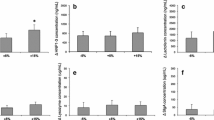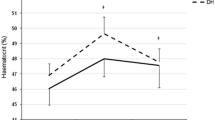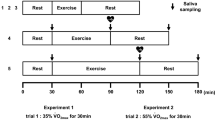Abstract
There are many factors in mucosal secretions that contribute to innate immunity and the ‘first line of defence’ at mucosal surfaces. Few studies, however, have investigated the effects of exercise on many of these ‘defence’ factors. The aim of the present study was to determine the acute effects of prolonged exercise on salivary levels of selected antimicrobial peptides (AMP) that have not yet been studied in response to exercise (HNP1–3 and LL-37) in addition to immunoglobulin A (IgA). A secondary objective was to assess the effects of exercise on saliva antibacterial capacity. Twelve active men exercised on a cycle ergometer for 2.5 h at ~60% of maximal oxygen uptake. Unstimulated whole saliva samples were obtained before and after exercise. There was a significant decrease (P < 0.05) in salivary IgA:osmolality ratio, following exercise, but IgA concentration and secretion rate were unaltered. Salivary HNP1–3 and LL-37 concentrations (P < 0.01 and P < 0.05, respectively), concentration:osmolality ratios (P < 0.01) and secretion rates (P < 0.01) all increased following exercise. Salivary antibacterial capacity (against E. coli) did not change. The increased concentration of AMPs in saliva may confer some benefit to the ‘first line of defence’ and could result from synergistic compensation within the mucosal immune system and/or airway inflammation and epithelial damage. Further study is required to determine the significance of such changes on the overall ‘defence’ capacity of saliva and how this influences the overall risk for infection.

Similar content being viewed by others
References
Allgrove JE, Gomes E, Hough J, Gleeson M (2008) Effect of exercise intensity on salivary antimicrobial proteins and markers of stress in active men. J Sports Sci 26:653–661. doi:10.1080/02640410701716790
Amerongen AV, Veerman EC (2002) Saliva––the defender of the oral cavity. Oral Dis 8:12–22. doi:10.1034/j.1601-0825.2002.1o816.x
Bachrach G, Chaushu G, Zigmond M, Yefenof E, Stabholz A, Shapira J, Merrick J, Chaushu S (2006) Salivary LL-37 secretion in individuals with Down syndrome is normal. J Dent Res 85:933–936. doi:10.1177/154405910608501012
Bals R (2000) Epithelial antimicrobial peptides in host defence against infection. Respir Res 1:141–150. doi:10.1186/rr25
Bender JS, Thang H, Glogauer M (2006) Novel rinse assay for the quantification of oral neutrophils and the monitoring of chronic periodontal disease. J Periodontal Res 41:214–220. doi:10.1111/j.1600-0765.2005.00861.x
Bermon S (2007) Airway inflammation and upper respiratory tract infection in athletes: is there a link? Exerc Immunol Rev 13:6–14
Blannin AK, Robson PJ, Walsh NP, Clark AM, Glennon L, Gleeson M (1998) The effect of exercising to exhaustion at different intensities on saliva immunoglobulin A, protein and electrolyte secretion. Int J Sports Med 19:547–552. doi:10.1055/s-2007-971958
Bowdish DM, Davidson DJ, Hancock RE (2005a) A re-evaluation of the role of host defence peptides in mammalian immunity. Curr Protein Pept Sci 6:35–51. doi:10.2174/1389203053027494
Bowdish DM, Davidson DJ, Lau YE, Lee K, Scott MG, Hancock RE (2005b) Impact of LL-37 on anti-infective immunity. J Leukoc Biol 77:451–459. doi:10.1189/jlb.0704380
Dale BA, Tao R, Kimball JR, Jurevic RJ (2006) Oral antimicrobial peptides and biological control of caries. BMC Oral Health 6:S13. doi:10.1186/1472-6831-6-S1-S13
Davison G, Gleeson M (2005) Influence of acute vitamin C and/or carbohydrate ingestion on hormonal, cytokine, and immune responses to prolonged exercise. Int J Sport Nutr Exerc Metab 15:465–479
Davison G, Gleeson M (2006) The effect of 2 weeks vitamin C supplementation on immunoendocrine responses to 2.5 h cycling exercise in man. Eur J Appl Physiol 97:454–461. doi:10.1007/s00421-006-0196-7
Davison G, Gleeson M (2007) The effects of acute vitamin C supplementation on cortisol, interleukin-6, and neutrophil responses to prolonged cycling exercise. Eur J Sport Sci 7:15–25. doi:10.1080/17461390701197734
Davison G, Gleeson M, Phillips S (2007) Antioxidant supplementation and immunoendocrine responses to prolonged exercise. Med Sci Sports Exerc 39:645–652. doi:10.1249/mss.0b013e318031303d
De Smet K, Contreras R (2005) Human antimicrobial peptides: defensins, cathelicidins and histatins. Biotechnol Lett 27:1337–1347. doi:10.1007/s10529-005-0936-5
Fahlman MM, Engels HJ (2005) Mucosal IgA and URTI in American collage football players: a year longitudinal study. Med Sci Sports Exerc 37:374–380. doi:10.1249/01.MSS.0000155432.67020.88
Ganz T (2003) Defensins: antimicrobial peptides of innate immunity. Nat Rev Immunol 3:710–720. doi:10.1038/nri1180
Gleeson M (2000) Salivary mucosal immunity and respiratory illness in elite athletes. Int J Sports Med 21:S33–S43. doi:10.1055/s-2000-1450
Gleeson M (2007) Immune function in sport and exercise. J Appl Physiol 103:693–699. doi:10.1152/japplphysiol.00008.2007
Gleeson M, Pyne DB (2000) Special feature for the olympics: effects of exercise on the immune system: exercise effects on mucosal immunity. Immunol Cell Biol 78:536–544. doi:10.1046/j.1440-1711.2000.00956.x
Gleeson M, McDonald WA, Pyne DB, Cripps AW, Francis JL, Fricker PA, Clancy RL (1999) Salivary IgA levels and infection risk in elite swimmers. Med Sci Sports Exerc 31:67–73. doi:10.1097/00005768-199901000-00012
Hoffman-Goetz L, Pedersen BK (1994) Exercise and the immune system: a model of the stress response? Immunol Today 15:382–387. doi:10.1016/0167-5699(94)90177-5
Krzywkowski K, Petersen EW, Ostrowski K, Link-Amster H, Boza J, Halkjaer-Kristensen J, Pedersen BK (2001) Effect of glutamine and protein supplementation on exercise-induced decreases in salivary IgA. J Appl Physiol 91:832–838
Li TL, Gleeson M (2004) The effect of single and repeated bouts of prolonged cycling and circadian variation on saliva flow rate, immunoglobulin A and alpha-amylase responses. J Sports Sci 22:1015–1024. doi:10.1080/02640410410001716733
Lukac J, Mravak-Stipetić M, Knezević M, Vrcek J, Sistig S, Ledinsky M, Kusić Z (2003) Phagocytic functions of salivary neutrophils in oral mucous membrane diseases. J Oral Pathol Med 32:271–274
Mackinnon LT, Jenkins DG (1993) Decreased salivary IgA after intense interval exercise before and after training. Med Sci Sports Exerc 25:678–683. doi:10.1249/00005768-199306000-00005
Mellander L, Bjørkander J, Carlsson B, Hanson LA (1986) Secretory antibodies in IgA-deficient and immunosuppressed individuals. J Clin Immunol 6:284–291. doi:10.1007/BF00917328
Müns G (1994) Effect of long-distance running on polymorphonuclear neutrophil phagocytic function of the upper airways. Int J Sports Med 15:96–99. doi:10.1055/s-2007-1021027
Murakami M, Ohtake T, Dorschner RA, Gallo RL (2002) Cathelicidin antimicrobial peptides are expressed in salivary glands and saliva. J Dent Res 81:845–850. doi:10.1177/154405910208101210
Neville V, Gleeson M, Folland JP (2008) Salivary IgA as a risk factor for upper respiratory infections in elite professional athletes. Med Sci Sports Exerc 40:1228–1236. doi:10.1249/MSS.0b013e31816be9c3
Nieman DC, Henson DA, Fagoaga OR, Utter AC, Vinci DM, Davis JM, Nehlsen-Cannarella SL (2002) Change in salivary IgA following a competitive marathon race. Int J Sports Med 23:69–75. doi:10.1055/s-2002-19375
Pütsep K, Carlsson G, Boman HG, Andersson M (2002) Deficiency of antibacterial peptides in patients with morbus Kostmann: an observation study. Lancet 360:1144–1149. doi:10.1016/S0140-6736(02)11201-3
Pyne DB (1994) Regulation of neutrophil function during exercise. Sports Med 17:245–258. doi:10.2165/00007256-199417040-00005
Radek K, Gallo R (2007) Antimicrobial peptides: natural effectors of the innate immune system. Semin Immunopathol 29:27–43. doi:10.1007/s00281-007-0064-5
Rogers HJ, Synge C (1978) Bacteriostatic effect of human milk on Escherichia coli: the role of IgA. Immunology 34:19–28
Shiomi K, Nakazato M, Ihi T, Kanagawa K, Matsuo H, Matsukura S (1993) Establishment of radioimmunoassay for human neutrophil peptides and their increases in plasma and neutrophil in infection. Biochem Biophys Res Commun 195:1336–1344. doi:10.1006/bbrc.1993.2190
Singh PK, Tack BF, McCray PB Jr, Welsh MJ (2000) Synergistic and additive killing by antimicrobial factors found in human airway surface liquid. Am J Physiol Lung Cell Mol Physiol 279:L799–L805
Smith JA, Pyne DB (1997) Exercise, training and neutrophil function. Exerc Immunol Rev 3:96–117
Steerenberg PA, van Asperen IA, Nieuw Amerongen A, Biewenga A, Mol D, Medema GJ (1997) Salivary levels of immunoglobulin A in triathletes. Eur J Oral Sci 105:305–309. doi:10.1111/j.1600-0722.1997.tb00245.x
Tanida T, Ueta E, Tobiume A, Hamada T, Rao F, Osaki T (2001) Influence of aging on candidal growth and adhesion regulatory agents in saliva. J Oral Pathol Med 30:328–335. doi:10.1034/j.1600-0714.2001.300602.x
Tanida T, Okamoto T, Okamoto A, Wang H, Hamada T, Ueta E, Osaki T (2003) Decreased excretion of antimicrobial proteins and peptides in saliva of patients with oral candidiasis. J Oral Pathol Med 32:586–594. doi:10.1034/j.1600-0714.2003.00015.x
Tao R, Jurevic RJ, Coulton KK, Tsutsui MT, Roberts MC, Kimball JR, Wells N, Berndt J, Dale BA (2005) Salivary antimicrobial peptide expression and dental caries experience in children. Antimicrob Agents Chemother 49:3883–3888. doi:10.1128/AAC.49.9.3883-3888.2005
Tenovuo J (2002) Antimicrobial agents in saliva—protection for the whole body. J Dent Res 81:807–809
Tjabringa GS, Rabe KF, Hiemstra PS (2005) The human cathelicidin LL-37: a multifunctional peptide involved in infection and inflammation in the lung. Pulm Pharmacol Ther 18:321–327. doi:10.1016/j.pupt.2005.01.001
Vanhatalo A, Doust JH, Burnley M (2007) Determination of critical power using a 3-min all-out cycling test. Med Sci Sports Exerc 39:548–555. doi:10.1249/mss.0b013e31802dd3e6
West NP, Pyne DB, Renshaw G, Cripps AW (2006) Antimicrobial peptides and proteins, exercise and innate mucosal immunity. FEMS Immunol Med Microbiol 48:293–304. doi:10.1111/j.1574-695X.2006.00132.x
West NP, Pyne DB, Kyd JM, Renshaw GM, Fricker PA, Cripps AW (2008) The effect of exercise on innate mucosal immunity. Br J Sports Med (May 22). doi:10.1136/bjsm.2008.046532
Author information
Authors and Affiliations
Corresponding author
Rights and permissions
About this article
Cite this article
Davison, G., Allgrove, J. & Gleeson, M. Salivary antimicrobial peptides (LL-37 and alpha-defensins HNP1–3), antimicrobial and IgA responses to prolonged exercise. Eur J Appl Physiol 106, 277–284 (2009). https://doi.org/10.1007/s00421-009-1020-y
Accepted:
Published:
Issue Date:
DOI: https://doi.org/10.1007/s00421-009-1020-y




